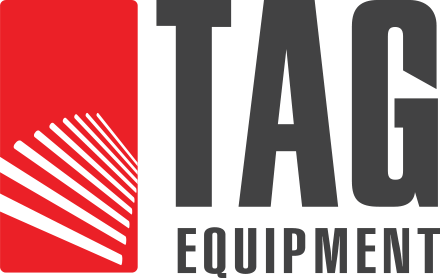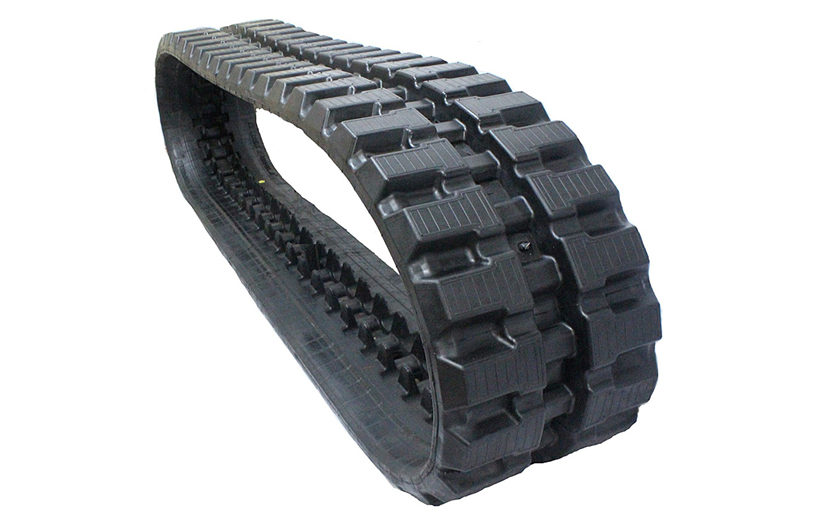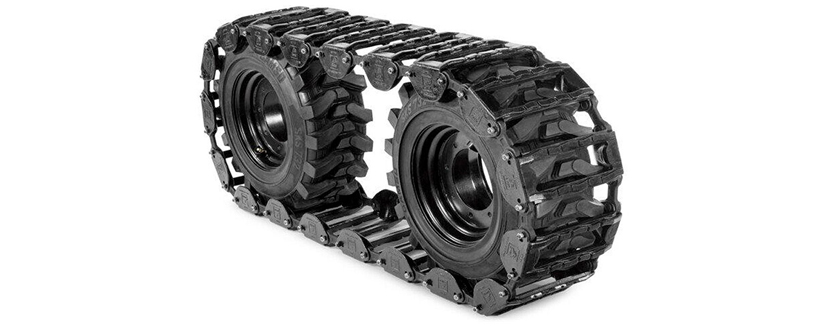When it comes to optimizing your skid steer’s performance, the choice between skid steer tracks and over-the-tire (OTT) tracks plays a critical role. Skid steers are versatile machines that excel in a range of industries, including construction, landscaping, agriculture, and demolition. However, their efficiency and capability depend heavily on their track system.
Making the right choice requires understanding how these track systems work, their advantages, and their suitability for different conditions. This article provides a detailed comparison of skid steer tracks and OTT tracks, helping you decide which option best suits your operations, whether it’s long-term durability, temporary traction, or cost-effectiveness.
Overview of Each Track Type
Skid Steer Tracks
Key Features
- Continuous Ground Contact:
Skid steer tracks maintain consistent ground contact due to their continuous design. Unlike tires, which only touch the ground at specific points, tracks distribute weight evenly across their entire surface. This reduces the risk of slippage and provides exceptional traction, even in loose or unstable conditions like gravel, mud, or compacted dirt. - Enhanced Stability on Slopes:
When working on inclines or uneven terrain, the broad surface area of skid steer tracks prevents tipping or sliding, allowing for safer and more precise operation. This stability is critical in environments where maintaining balance is a challenge, such as steep hillsides or heavily eroded land. - Low Ground Pressure:
By spreading the machine’s weight over a larger area, skid steer tracks exert significantly less ground pressure than tires. This feature minimizes the risk of sinking into soft ground, making tracks ideal for wetlands, snow, or muddy conditions. It also helps prevent damage to sensitive surfaces, such as freshly prepared soil or delicate landscaping areas. - Durable Construction Materials:
Skid steer tracks are engineered to endure heavy-duty use. Rubber tracks are reinforced with materials like steel cords or Kevlar to resist punctures, cracking, and wear, while steel tracks are nearly indestructible in extreme environments, making them perfect for abrasive or rocky terrain. - Improved Load-Bearing Capacity:
Skid steer tracks can support heavier loads compared to tires. Their ability to handle large loads without sinking or destabilizing the machine makes them invaluable in construction and demolition applications. - Shock Absorption:
Rubber tracks offer natural shock-absorbing properties, which reduce vibrations transmitted to the operator. This increases comfort during extended work hours and reduces stress on the machine’s components, improving its longevity.
Applications
- Construction Sites:
Skid steer tracks excel in construction environments where gravel, dirt, and uneven surfaces are common. Their stability and traction enable operators to move heavy materials and complete tasks efficiently, even on challenging terrain. - Demolition Projects:
The durability and toughness of skid steer tracks make them well-suited for demolition work. Tracks allow the machine to navigate over debris, broken concrete, and other obstacles without risking damage to the undercarriage. - Landscaping:
Tracks are ideal for landscaping projects where surface protection is important. Their low ground pressure minimizes turf damage, making them perfect for working on lawns, gardens, and other soft surfaces. - Forestry:
In wooded areas, skid steer tracks provide the traction needed to navigate over logs, roots, and uneven terrain. Their robust design ensures that the machine can handle the tough conditions often encountered in forestry work. - Snow and Ice:
Skid steer tracks maintain superior grip in winter conditions, preventing slippage on icy or snow-covered surfaces. This makes them invaluable for snow removal and winter maintenance tasks. - Heavy-Duty Excavation:
Skid steer tracks offer the stability and load-bearing capacity required for digging and excavation tasks, allowing operators to work efficiently without worrying about machine stability.
Over-the-Tire Tracks
Key Features
- Quick Installation and Removal:
Over-the-tire tracks are designed for rapid deployment. Most systems can be installed or removed in under an hour, depending on the track model and tire configuration. This flexibility allows operators to switch between tires and tracks as needed, adapting quickly to changes in job site conditions. - Adaptable Traction:
OTT tracks enhance a wheeled skid steer’s ability to perform in challenging conditions. They significantly improve traction in mud, snow, or sand by providing additional surface area and grip, enabling the machine to handle tasks that would otherwise be impossible with standard tires. - Versatility for Mixed Conditions:
OTT tracks are perfect for contractors who work across diverse terrains. Whether transitioning from a paved lot to a muddy construction site or navigating between compact soil and soft sand, OTT tracks provide the adaptability needed to maintain consistent performance. - Cost-Effective Solution:
For contractors or small businesses that occasionally need improved traction, OTT tracks are a budget-friendly alternative to purchasing a dedicated tracked machine. They provide many of the benefits of skid steer tracks without requiring a full equipment upgrade. - Durable Design for Temporary Use:
Modern OTT tracks are built to handle temporary heavy use, with materials like hardened steel or reinforced rubber ensuring they can withstand tough conditions. However, they are not intended for long-term heavy-duty applications, which helps keep their cost lower. - Protection for Tires:
OTT tracks can shield the tires from direct contact with sharp objects, such as rocks or debris. This reduces the risk of punctures and extends the lifespan of the skid steer’s tires, making them a practical choice for occasional rugged terrain.
Applications
- Seasonal Operations:
OTT tracks are ideal for contractors who face changing terrain due to seasonal weather conditions. For example, they are commonly used during the winter months to provide extra traction for snow removal or ice-covered job sites. - Temporary Traction Needs:
When a project involves soft, unstable ground such as mud or sand, OTT tracks offer a quick and effective way to enhance a wheeled skid steer’s performance. They allow operators to tackle these conditions without committing to a permanent track system. - Mixed-Terrain Projects:
Contractors who work on sites that include both hard and soft surfaces benefit from the adaptability of OTT tracks. For instance, operators can drive the skid steer on paved roads and then engage the tracks for off-road tasks without requiring a machine change. - Small-Scale Construction:
OTT tracks are well-suited for smaller construction projects where full-time tracked equipment isn’t necessary. Their affordability and ease of use make them an attractive option for budget-conscious contractors. - Landscaping with Varied Surfaces:
When working on properties that combine grass, soil, and pavement, OTT tracks offer the flexibility to switch between soft and hard surfaces while minimizing ground damage. - Emergency Situations:
OTT tracks are a practical choice for unexpected terrain challenges. For instance, if heavy rains turn a stable site into a muddy mess, OTT tracks can be quickly installed to keep operations running smoothly.
Pros and Cons of Each Option
Skid Steer Tracks
Pros:
- Superior Stability and Traction:
Tracks provide stability in demanding environments, reducing slippage and ensuring precise movements. - Durability for Long-Term Use:
Designed for heavy-duty applications, skid steer tracks are built to withstand harsh conditions, offering a longer lifespan compared to OTT tracks. - Reduced Impact on Soft Surfaces:
By spreading weight across a larger surface area, skid steer tracks minimize ground disturbance, making them suitable for landscaping or wet terrains.
Cons:
- High Initial Costs:
The purchase and installation of skid steer tracks represent a significant upfront investment, particularly for small contractors. - Maintenance Requirements:
Rubber and steel tracks require regular inspection, cleaning, and tension adjustments to maintain performance, which adds to operational costs. - Less Adaptability:
Once installed, skid steer tracks are designed for specific terrains, making them less practical for jobs requiring frequent transitions between hard and soft surfaces.
Over-the-Tire Tracks (OTT Tracks)
Pros:
- Cost-Effective Alternative:
OTT tracks allow operators to improve traction without investing in a dedicated tracked machine, making them an economical solution. - Quick Installation and Removal:
The ability to easily switch between tracks and wheels makes OTT tracks an excellent choice for projects with varying terrain needs. - Versatile Applications:
OTT tracks enhance performance on soft terrains such as mud, snow, or sand, making them ideal for contractors who work on seasonal or occasional projects.
Cons:
- Shorter Lifespan:
Compared to skid steer tracks, OTT tracks are less durable and may need replacement sooner, especially under heavy use. - Potential Tire Damage:
Prolonged use of OTT tracks can increase wear on the skid steer’s tires, leading to additional maintenance and replacement costs. - Limited Effectiveness in Extreme Conditions:
While versatile, OTT tracks cannot match the stability and durability of permanent skid steer tracks on particularly rough or rocky terrain.
Key Factors to Consider When Choosing
Terrain and Job Requirements
Terrain plays a critical role in selecting the right track system:
- Skid Steer Tracks: Designed for rugged, uneven terrains like gravel, rocky paths, and steep inclines. They excel in conditions that demand long-term stability and traction.
- OTT Tracks: Best suited for softer, temporary conditions like mud, sand, or snow. They are ideal for operators who frequently switch between challenging and stable surfaces.
Budget Constraints
Your budget will determine which option is feasible for your operations:
- Skid Steer Tracks: Higher upfront investment but cost-effective over time due to their durability and longevity.
- OTT Tracks: A more affordable initial option, especially for contractors who occasionally need tracks for specific projects.
Maintenance Needs
Maintenance requirements should be considered to manage long-term costs:
- Skid Steer Tracks: Regular cleaning, tension adjustments, and inspections are needed to maintain performance and prolong lifespan.
- OTT Tracks: Easier to maintain but may cause faster wear on tires, requiring periodic replacements.
When to Choose Skid Steer Tracks
Choose skid steer tracks when:
- Your projects involve heavy-duty tasks like demolition, excavation, or forestry.
- The terrain is consistently rugged or uneven.
- Long-term use and durability are essential to your operations.
When to Choose Over-the-Tire Tracks
Choose OTT tracks when:
- You need a temporary solution for added traction in muddy, snowy, or sandy environments.
- Your budget doesn’t allow for permanent track systems.
- Flexibility and quick adaptability are essential for your projects.
Why Tag Equipment is Your Go-To Source for Tracks
Tag Equipment is a trusted provider of high-quality skid steer tracks and OTT tracks in Canada.
- Extensive Inventory: We offer a wide range of durable and reliable track systems tailored to Canadian conditions.
- Expert Guidance: Our team of professionals provides personalized recommendations to help you choose the right track system for your needs.
- Canadian Expertise: With experience in handling diverse terrains and weather conditions, we deliver solutions that maximize performance and efficiency.
FAQ Section
Q: Can OTT tracks handle heavy loads?
A: OTT tracks are suitable for moderate to heavy loads but may wear out faster than skid steer tracks under continuous heavy-duty use.
Q: How long do skid steer tracks last?
A: With proper maintenance, rubber tracks can last between 1,200 and 2,000 operating hours, while steel tracks often last longer in extreme conditions.
Q: Are skid steer tracks worth the investment?
A: Yes, for operators who work on rugged terrains or require long-term stability, skid steer tracks provide excellent value through durability and performance.
Q: Are OTT tracks compatible with all skid steers?
A: Most OTT tracks fit standard tire sizes, but it’s essential to verify compatibility with your specific skid steer model.
Making the Right Track Choice for Your Skid Steer
Both skid steer tracks and over-the-tire tracks offer unique advantages, but the best choice depends on your specific needs. Skid steer tracks provide exceptional durability and performance for heavy-duty applications, while OTT tracks deliver flexibility and affordability for temporary or varied terrain challenges.
Still unsure? Contact Tag Equipment today for expert advice and explore our extensive selection of high-quality tracks to find the perfect fit for your skid steer.


